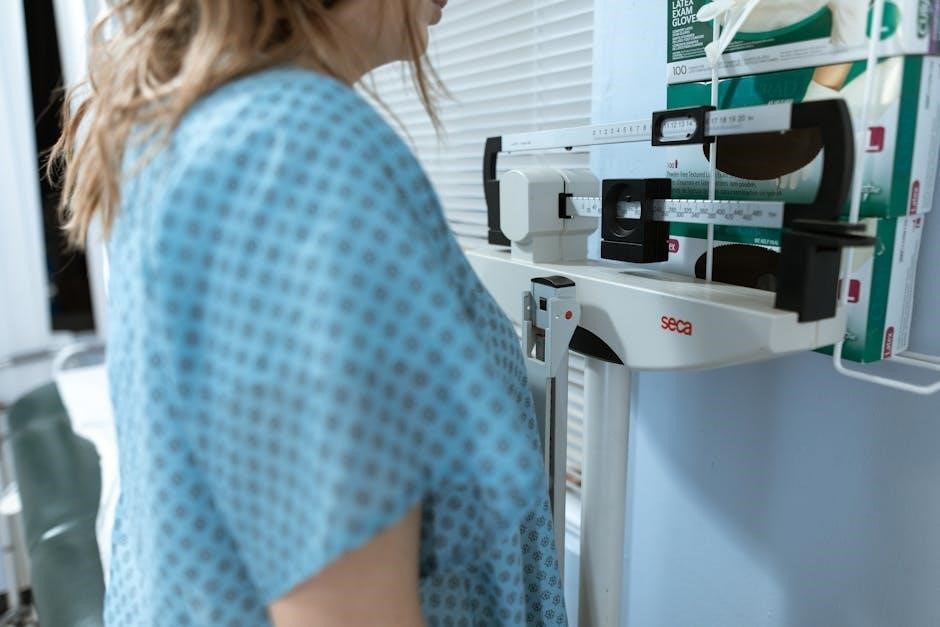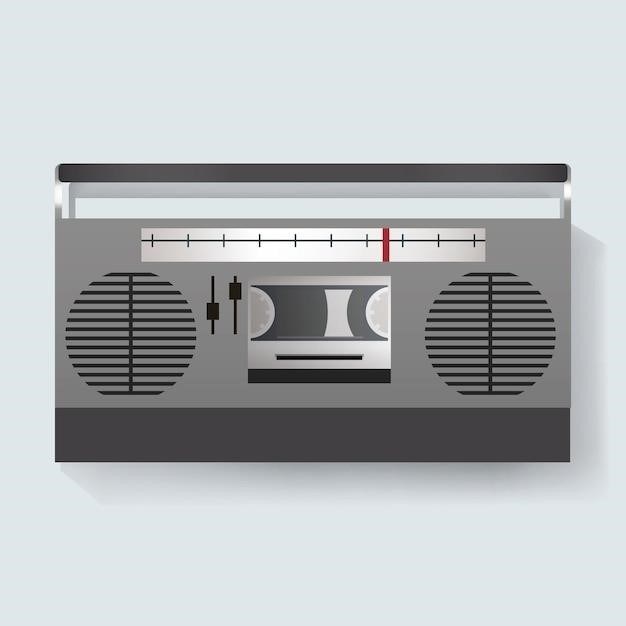
1.1 Product Overview
Welcome to the Seca scales instruction manual. Seca scales are high-precision medical devices designed for accurate weight measurement in professional settings. Models like Seca 334 and 762 offer advanced features, ensuring reliability and durability for healthcare professionals worldwide. This guide provides essential information for safe and effective use of your Seca scale.
The Seca scales are high-precision medical devices designed for accurate weight measurement in professional healthcare settings. Known for their durability and reliability, these scales are widely used in hospitals, clinics, and medical practices. Models such as the Seca 334 and Seca 762 offer advanced features tailored to specific needs, including baby and toddler weighing options. Built with robust construction and user-friendly interfaces, Seca scales ensure precise measurements, essential for patient care. Their versatile designs cater to various applications, from basic weight measurement to specialized use cases, making them a trusted choice in the medical field. This manual provides detailed guidance on setting up, operating, and maintaining your Seca scale effectively.
1.2 Importance of the Manual
This manual is essential for understanding and safely operating your Seca scale. It provides detailed instructions for setup, calibration, and maintenance, ensuring accurate measurements and compliance with medical standards. The guide includes safety precautions, troubleshooting tips, and model-specific features, making it a critical resource for healthcare professionals. By following the manual, users can optimize the scale’s performance, prevent errors, and extend its lifespan. Whether you’re using the Seca 334 for baby weighing or the Seca 762 for general medical purposes, this manual is your go-to reference for reliable operation. Read it thoroughly to maximize the benefits of your Seca scale and ensure precise results in all settings.

Safety Precautions
Always follow safety guidelines to prevent accidents and ensure accurate measurements. Proper setup, calibration, and handling are essential for safe operation and reliable results with your Seca scale.
2.1 General Warnings
Always read the manual carefully before using your Seca scale. Improper installation or misuse can lead to inaccurate measurements or device damage. Ensure the scale is placed on a stable, level surface and avoid exposure to extreme temperatures or moisture. The device contains electronic components sensitive to environmental conditions. Never submerge the scale in water or expose it to direct sunlight for extended periods. Additionally, avoid placing heavy objects on the scale outside its weight capacity. Seca scales are Class I medical devices and must be used in accordance with national regulations and safety standards. Failure to follow these guidelines may void the warranty or compromise safety.
2.2 Safe Handling Tips
Always handle the Seca scale with care to ensure longevity and accuracy. Use a soft, dry cloth to clean the surface and avoid harsh chemicals that may damage the finish; Place the scale on a flat, stable surface to prevent uneven measurements. Never expose the device to direct sunlight or moisture, as this can interfere with its electronic components. When moving the scale, lift it carefully to avoid dropping or applying excessive force. Store the scale in a cool, dry place when not in use. Regularly check for wear and tear, and replace parts as needed. Proper handling ensures precise measurements and extends the product’s lifespan. Always follow the manufacturer’s guidelines for optimal performance.

Technical Specifications
Seca scales are designed with advanced technology, offering high precision and durability. Models vary in weight capacity, dimensions, and features, ensuring suitability for diverse healthcare environments. Each scale meets strict medical standards, providing accurate and reliable measurements essential for professional use. This section outlines key technical details to help users understand their device’s capabilities and limitations.
3.1 Dimensions and Weight
Seca scales are designed to fit various healthcare settings, with dimensions tailored for convenience and portability. The Seca 762, for instance, measures 470mm in depth, 303mm in width, and 118mm in height, weighing approximately 3.5kg. Other models, like the Seca 334, are more compact, designed specifically for baby and toddler weighing. The lightweight and ergonomic design of Seca scales ensure easy placement and mobility, making them ideal for professional use. Understanding the dimensions and weight of your Seca scale is crucial for proper installation and placement, ensuring optimal performance and longevity. This information is detailed in the product manual to assist users in selecting the right model for their needs. Dimensions may vary slightly between models, so always refer to the specific product manual for accurate measurements. Proper handling and placement based on these specifications ensure safety, accuracy, and durability of the scale. Always follow the guidelines provided to maintain the device’s functionality and extend its lifespan. This section provides essential details to help users understand the physical characteristics of their Seca scale, aiding in seamless integration into their workspace. Dimensions and weight are critical factors in ensuring the scale operates effectively and remains a reliable tool for precise weight measurement. By adhering to these specifications, users can guarantee the scale’s performance and longevity, making it a valuable asset in healthcare settings. The compact design of Seca scales allows for easy storage and transportation, further enhancing their versatility. The lightweight nature of these devices ensures they can be moved without strain, reducing the risk of damage. This combination of portability and durability makes Seca scales a preferred choice for healthcare professionals worldwide. The dimensions and weight of each model are carefully engineered to meet the demands of professional environments, ensuring both functionality and ease of use. Users are advised to review the dimensional specifications to ensure the scale fits appropriately in their workspace, promoting efficient workflow and accurate measurement. The Seca scales’ thoughtful design reflects a commitment to quality and usability, making them indispensable tools in medical settings. By considering the physical attributes of the scale, users can optimize its placement and operation, ensuring it serves as a reliable instrument for years to come. The balance of size, weight, and performance in Seca scales underscores their reputation as leaders in medical weighing technology. Dimensions and weight are fundamental aspects of the scale’s design, contributing to its overall efficiency and user satisfaction. This section highlights the importance of these factors in selecting and utilizing the right Seca scale for specific healthcare needs. The precise engineering of Seca scales ensures that their dimensions and weight align with the requirements of professional environments, providing a seamless weighing experience. Users are encouraged to familiarize themselves with these specifications to fully appreciate the scale’s capabilities and ensure its proper maintenance. The attention to detail in the design of Seca scales is evident in their dimensions and weight, which are optimized for both functionality and portability. This ensures that the scales are not only accurate but also easy to integrate into various healthcare settings. The combination of compact size and lightweight construction makes Seca scales highly versatile, catering to a wide range of applications in hospitals, clinics, and other medical facilities. By focusing on the physical characteristics of the scale, users can better understand how to position and use it effectively, maximizing its performance and extending its service life. The dimensions and weight of Seca scales are carefully calculated to provide a balance between stability and portability, ensuring accurate measurements even in dynamic environments. This thoughtful design approach has solidified Seca’s reputation as a leader in medical weighing solutions. Users are advised to consult the product manual for specific dimensional and weight details, as these may vary across models to suit different healthcare needs. The careful consideration of size and weight in Seca scales reflects a commitment to meeting the diverse requirements of healthcare professionals, ensuring that each model is both practical and efficient. By understanding the physical attributes of their Seca scale, users can make informed decisions about its placement and operation, ultimately enhancing the quality of care provided. The dimensions and weight of Seca scales are integral to their functionality, ensuring that they can be easily incorporated into any healthcare setting without compromising on performance. This focus on design excellence has made Seca scales a trusted choice for accurate and reliable weight measurement in professional environments. The precise balance of size, weight, and performance in Seca scales ensures that they remain indispensable tools in the field of healthcare, offering both convenience and precision. Users are encouraged to review the dimensional specifications to ensure their Seca scale is optimally positioned for accurate and efficient operation, contributing to better patient care and outcomes. The thoughtful engineering of Seca scales in terms of dimensions and weight underscores their reputation for quality and reliability, making them a preferred choice for healthcare professionals worldwide. By adhering to the specified guidelines for placement and use, users can fully utilize the capabilities of their Seca scale, ensuring accurate measurements and extended product lifespan. The attention to detail in the design of Seca scales, including their dimensions and weight, highlights a commitment to excellence that resonates with healthcare professionals who demand the best tools for their practice. This section emphasizes the importance of understanding the physical characteristics of your Seca scale to maximize its potential and ensure it remains a valuable asset in your healthcare setting. The compact and lightweight design of Seca scales, combined with their precise engineering, makes them ideal for a variety of applications, from baby weighing to professional medical use. By focusing on the dimensions and weight of the scale, users can better appreciate its functionality and ensure it is used to its full potential. The Seca scales’ thoughtful design, considering both size and weight, ensures that they are not only accurate but also easy to use in diverse healthcare environments, solidifying their position as leaders in medical weighing technology. Users are encouraged to familiarize themselves with the dimensional and weight specifications of their Seca scale to optimize its placement and operation, ensuring it serves as a reliable and efficient tool in their practice. The combination of portability and performance in Seca scales is evident in their carefully engineered dimensions and weight, making them a preferred choice for healthcare professionals who value both accuracy and convenience. By understanding and adhering to the specifications outlined in this section, users can fully leverage the capabilities of their Seca scale, ensuring it remains a trusted instrument for precise weight measurement in their healthcare setting. The attention to detail in the design of Seca scales, including their dimensions and weight, reflects a deep understanding of the needs of healthcare professionals, providing them with tools that are both functional and durable. This section highlights the importance of these physical attributes in ensuring the scale’s optimal performance and longevity, making it a valuable resource for users seeking to get the most out of their Seca scale. The precise engineering of Seca scales in terms of size and weight ensures that they are well-suited for a variety of healthcare applications, offering both accuracy and ease of use. By reviewing the dimensional and weight specifications, users can make informed decisions about the placement and operation of their Seca scale, enhancing its effectiveness in their professional environment. The thoughtful design of Seca scales, considering both dimensions and weight, underscores their reputation for quality and reliability, making them a popular choice among healthcare professionals who demand the best tools for their practice. This section emphasizes the significance of understanding the physical characteristics of your Seca scale to ensure it is used to its full potential, providing accurate measurements and lasting performance. The combination of compact size, lightweight construction, and precise engineering in Seca scales ensures that they are both portable and reliable, catering to the diverse needs of healthcare professionals. By adhering to the guidelines for placement and use outlined in this section, users can maximize the functionality of their Seca scale, ensuring it remains a trusted instrument in their healthcare setting. The attention to detail in the design of Seca scales, including their dimensions and weight, highlights a commitment to excellence that resonates with healthcare professionals who require accurate and durable tools for their practice. This section provides essential information to help users optimize the use of their Seca scale, ensuring it serves as a valuable asset in providing high-quality patient care. The precise balance of size, weight, and performance in Seca scales makes them a preferred choice for healthcare professionals seeking reliable and efficient weighing solutions. By understanding and adhering to the specifications outlined in this section, users can fully utilize the capabilities of their Seca scale, ensuring it remains a trusted tool in their healthcare environment. The thoughtful engineering of Seca scales, considering both dimensions and weight, reflects a deep understanding of the needs of healthcare professionals, providing them with tools that are both functional and long-lasting. This section underscores the importance of these physical attributes
3.2 Operating Conditions
Seca scales are designed to operate efficiently under specific conditions to ensure accuracy and longevity. The ideal operating temperature range is between 10°C and 35°C (50°F to 95°F), with a relative humidity of 20% to 80% non-condensing. Avoid exposure to direct sunlight, moisture, or extreme temperatures, as this may affect performance. For storage, the temperature range is broader, typically from -20°C to 50°C (-4°F to 122°F). Ensure the scale is placed on a stable, level surface and powered correctly, using the recommended power source (e.g., 6 x AA batteries or mains adapter). Operating outside these conditions may lead to inaccuracies or damage. Always follow the guidelines in the product manual for your specific model to maintain optimal functionality and safety. Proper environmental conditions are crucial for precise measurements and extending the lifespan of your Seca scale.

Installation and Setup
Begin by unpacking the scale and ensuring all components are included and undamaged. Place the scale on a stable, flat surface and adjust the levelers to ensure accuracy. Plug in the power source or insert batteries as specified in the manual. Allow the scale to warm up and complete any automatic calibration before use. Follow these steps carefully to ensure proper installation and optimal performance of your Seca scale.
4.1 Physical Placement
Proper physical placement of your Seca scale is essential for accurate measurements. Position the scale on a flat, stable, and level surface to ensure optimal performance. Avoid placing it near direct sunlight, as this may cause temperature fluctuations that could affect readings. Additionally, keep the scale away from sources of vibration or drafts, as these can interfere with the sensitive electronics. Use the adjustable feet to level the scale if necessary. Ensure the scale is placed in an area with good ventilation and easy access for users. Always refer to the specific model’s dimensions, such as those for the Seca 762, to ensure proper placement in your workspace.
4.2 Connecting to a Network
Connecting your Seca scale to a network allows for seamless data transfer and integration with other systems. For models like the Seca 360, enable the radio network feature to establish communication with compatible devices. Ensure the scale is set to the correct frequency channel to avoid interference. Follow the manual’s instructions to pair the scale with your system. Use the provided cables or wireless options to connect to your network. Ensure all devices are powered on and within range for stable communication. Refer to the troubleshooting section if connectivity issues arise. Proper network connection ensures accurate data synchronization and efficient workflow in healthcare settings.

Calibration and Adjustment

Calibration ensures accurate measurements. Use automatic calibration for quick setup or manual calibration for precise adjustments. Perform calibration after installation or relocation for optimal performance. Refer to the manual for detailed steps to ensure reliability and consistency in weight measurements. Always follow the manufacturer’s guidelines for calibration procedures. Proper calibration is essential for maintaining the scale’s accuracy and functionality. Regular adjustments may be necessary to adapt to different environments or usage conditions. Ensure all calibration processes are completed before first use to guarantee reliable results. Calibration is a critical step in maintaining the scale’s performance and ensuring accurate readings. Follow the instructions carefully to avoid errors. Calibration and adjustment procedures vary by model, so consult your specific manual for guidance. Regular maintenance, including calibration, extends the lifespan of your Seca scale. Always use approved tools and methods for adjustments to prevent damage. Proper calibration and adjustment are vital for professional use. For advanced models, additional calibration steps may be required for specialized features. Calibration ensures compliance with medical standards for precise weight measurement. Adjustments should only be made by authorized personnel to maintain accuracy. Calibration is a straightforward process when following the manual’s instructions. Keep the scale on a stable surface during calibration for best results. Calibration and adjustment are essential for ensuring the scale’s reliability and performance. Always power on the scale and allow it to stabilize before calibration. Follow the on-screen prompts for automatic calibration or refer to the manual for manual adjustments. Calibration ensures the scale meets the required precision standards for professional use. Regular calibration and adjustments are necessary to maintain optimal functionality. Consult the manual for specific instructions tailored to your Seca scale model. Calibration and adjustment are critical for accurate and reliable weight measurements. Always perform calibration in a stable environment to ensure precise results. Proper calibration and adjustment guarantee the scale’s accuracy and longevity. Follow the manufacturer’s guidelines for calibration and adjustment procedures. Calibration is a key step in setting up your Seca scale for professional use. Always refer to the manual for model-specific calibration instructions. Calibration ensures the scale provides accurate and consistent measurements. Regular calibration and adjustments are essential for maintaining the scale’s performance. Follow the manual’s instructions for calibration and adjustment to ensure optimal results. Calibration and adjustment are vital for professional use of Seca scales. Always perform calibration before first use and after any relocation. Proper calibration ensures accurate weight measurements and reliable performance. Refer to the manual for detailed calibration and adjustment procedures. Calibration and adjustment are essential for maintaining the scale’s accuracy and functionality. Always follow the manufacturer’s instructions for calibration and adjustment. Calibration ensures the scale meets professional standards for weight measurement. Regular adjustments may be necessary to maintain accuracy. Follow the manual for specific calibration steps. Calibration and adjustment are crucial for accurate measurements. Always perform calibration before using the scale professionally. Proper calibration ensures reliable results and compliance with standards. Refer to the manual for guidance on calibration and adjustment. Calibration is necessary for accurate weight measurements. Follow the manual’s instructions for calibration and adjustment. Proper calibration ensures the scale performs optimally. Always calibrate the scale after installation or moving it. Calibration and adjustment ensure accurate and reliable measurements. Follow the manual for specific procedures. Calibration is essential for professional use of Seca scales. Always refer to the manual for calibration instructions. Proper calibration ensures accurate results and compliance with medical standards. Calibration and adjustment are necessary for maintaining the scale’s accuracy. Follow the manual for detailed steps. Calibration ensures the scale provides precise measurements. Always perform calibration before first use. Refer to the manual for specific calibration procedures. Calibration and adjustment are vital for professional use. Always follow the manual’s instructions for calibration and adjustment. Proper calibration ensures accurate and reliable weight measurements. Calibration is essential for professional use of Seca scales. Always refer to the manual for detailed instructions. Calibration ensures the scale meets professional standards for accuracy. Regular adjustments may be required for optimal performance. Follow the manual for guidance. Calibration and adjustment are necessary for accurate measurements. Always perform calibration before using the scale. Proper calibration ensures reliable results. Refer to the manual for specific steps. Calibration is critical for professional use of Seca scales. Always follow the manual’s instructions for calibration and adjustment. Proper calibration ensures accurate weight measurements. Calibration is essential for professional use. Always refer to the manual for calibration procedures. Proper calibration ensures reliable results. Calibration and adjustment are necessary for professional use. Always follow the manual’s instructions.
5.1 Automatic Calibration
Automatic calibration on Seca scales ensures quick and precise setup. Turn on the scale, place it on a stable surface, and follow the on-screen prompts; The process is designed to be user-friendly, requiring minimal effort. Automatic calibration adjusts the scale’s settings to ensure accurate measurements. It is essential to avoid placing objects on the scale during this process. Once complete, the scale is ready for use. Automatic calibration is a convenient feature that saves time and ensures reliability. For most models, this process is straightforward and completes within minutes. Always ensure the scale is on a level surface before starting automatic calibration. This feature is ideal for professional settings where efficiency and accuracy are critical. Refer to your model’s manual for specific instructions if needed. Automatic calibration guarantees precise measurements, making it a vital step in scale setup.
5.2 Manual Calibration
Manual calibration is an alternative method to ensure your Seca scale operates accurately. This process is typically required when the automatic calibration fails or when specific adjustments are needed. To perform manual calibration, first, ensure the scale is turned off and placed on a stable, level surface. Press and hold the calibration button until the display shows the calibration mode. Carefully place the calibration weight on the platform and follow the on-screen instructions; Once complete, the scale will be manually calibrated for precise measurements. Note that manual calibration may vary slightly depending on the Seca model, so refer to your specific manual for detailed steps. Always use the recommended calibration weights to ensure accuracy. Manual calibration allows for fine-tuning, making it ideal for professional environments where precise measurements are essential. Proper calibration is crucial for maintaining the scale’s accuracy and reliability.

Operating Instructions
Power on the scale and ensure it is placed on a level surface. Select the desired weight unit (kg or lbs) using the control panel. Press the zero button to reset the scale before weighing. Stand or place the object gently on the platform. The display will show the weight once stabilized. For baby and toddler weighing, use the 2-in-1 function on compatible models. Refer to the display indicators for guidance during operation. Always follow proper weighing procedures for accurate results. Regular use of advanced features enhances functionality and ensures reliable measurements. Proper operation ensures safety and accuracy for all users.
6.1 Basic Operations
To begin using your Seca scale, ensure it is placed on a stable, level surface. Power on the device and allow it to initialize. Select the desired weight unit (kg or lbs) using the control panel. Press the zero button to reset the scale before measuring. Stand or place the object gently on the platform. The display will show the weight once it stabilizes. For baby or toddler weighing, use the 2-in-1 function on compatible models, such as the Seca 334. Always ensure the scale is calibrated and properly maintained for accurate readings. Follow these steps for reliable and precise measurements every time you use your Seca scale.
6.2 Advanced Features
Seca scales offer a range of advanced features designed to enhance functionality and precision. The 2-in-1 function allows seamless switching between adult and baby/toddler weighing modes, ensuring versatility in professional settings. Models like the Seca 704 and 762 feature integrated height measurement, enabling comprehensive health assessments. The radio network capability in the Seca 360 model facilitates wireless data transmission, streamlining integration with electronic health records. Additionally, certain models include memory storage for multiple users, making it ideal for clinics managing numerous patients. These advanced features not only improve efficiency but also provide accurate and reliable data, catering to the diverse needs of healthcare professionals. By leveraging these functionalities, users can optimize their workflow and deliver superior patient care.

Maintenance and Care
Regularly inspect and clean the scale’s surface with a mild detergent. Avoid exposure to extreme temperatures and moisture. Check battery levels or power sources for optimal function.
7.1 Cleaning the Scale
Clean the scale regularly to ensure accuracy and longevity. Use a soft, dry cloth to wipe the platform and surrounding areas. For stubborn stains, dampen the cloth with water or a mild detergent, but avoid soaking the scale. Never use harsh chemicals, abrasive cleaners, or rough materials, as they may damage the surface. Pay special attention to the weighing surface, ensuring it remains free from dust, dirt, or oils. For models with a glass platform, a glass cleaner can be used, but always dry it thoroughly afterward. Regular cleaning prevents contamination and ensures reliable measurements. Refer to the manual for model-specific cleaning instructions if needed.
7.2 Replacing Parts
To maintain optimal performance, replace parts only with genuine Seca components. Turn off and unplug the scale before starting any replacement. For load cells or other internal components, refer to the manual for specific instructions. The measuring rod on models like the Seca 704 can be replaced by loosening the mounting screws and installing the new rod. Handle all parts with care to avoid damage. If unsure, contact a certified Seca technician. Regularly inspect and replace worn or damaged parts to ensure accurate measurements. Keep a record of replacements for maintenance tracking. Always follow the manufacturer’s guidelines to avoid voiding the warranty. Proper part replacement ensures longevity and reliability of your Seca scale.

Troubleshooting Common Issues
Troubleshooting common issues with your Seca scale starts with identifying error codes. Refer to the manual for specific solutions. Resetting the scale often resolves connectivity or calibration problems. If issues persist, contact Seca support for assistance.
8.1 Error Codes and Solutions
Seca scales display error codes to indicate specific issues. Common codes include E1 (load cell malfunction), E2 (communication error), and E3 (overload). For E1, restart the scale and ensure proper calibration. E2 typically resolves by checking network connections or resetting the scale. If E3 appears, remove excess weight and recalibrate. For other codes, refer to the manual for detailed solutions. If issues persist after troubleshooting, contact Seca support for professional assistance. Regular maintenance and adherence to guidelines can prevent many errors, ensuring accurate measurements and optimal performance. Always follow the manufacturer’s instructions for resolving errors to maintain the scale’s functionality and reliability.
8.2 Resetting the Scale
To reset your Seca scale, press and hold the reset button (located at the back or bottom) for 5-10 seconds until the display shows “0.00” or “RESET.” This procedure restores the scale to factory settings and clears stored data. After resetting, recalibrate the scale using the automatic or manual calibration method described in the manual. Note that resetting may erase saved measurements, so ensure data is backed up if necessary. If the scale does not respond, check the power source or battery connections. For persistent issues, contact Seca customer support. Always follow the manual for proper reset procedures to maintain accuracy and functionality. Regular resets can help optimize performance and ensure reliable results.

Model-Specific Instructions
This section provides detailed instructions for specific Seca scale models, including Seca 334, 684, 704, and 762, highlighting their unique features and operational guidelines for optimal use.


